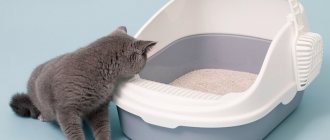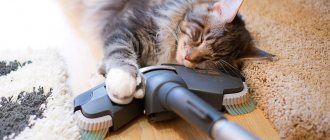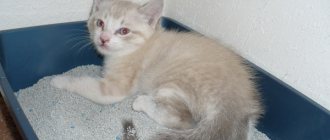The cat does not go to the toilet - the main reasons
Conventionally, all causes are divided into physiological, also known as medical, psychological or behavioral. In the first case, the cat stops defecating altogether, in the second, it does it in another place.
Physiological reasons
If a cat does not go to the toilet at all, there is only one reason - a disease of the genitourinary system. It develops against the background of poor nutrition, excessive consumption of vitamin-mineral complexes, a sedentary lifestyle, drafts, and freezing. A cat stops going to the toilet with the following diseases:
- cystitis;
- inflammation of the genital organs;
- cholelithiasis, urolithiasis;
- prostatitis;
- movement of stones along channels, sand.
It is impossible to make a diagnosis on your own or select a qualified treatment on your own. The pet must be shown to the veterinarian. During urination, severe pain and discomfort occurs. Since initially painful manifestations occur when going to the litter box, the animal begins to think that the toilet is to blame and begins to look for a more comfortable place. In a situation where the pet stops defecating altogether, this may indicate the movement of stones. In this case, the neoplasm blocks the excretory tract, and the pet simply cannot defecate. In the absence of timely medical care, the cat runs the risk of dying.
In addition to this oddity, other changes are observed in the animal’s behavior. Stops eating, sleeps poorly, shows drowsiness, apathy or aggression, meows often and for a long time, and follows the owner’s heels. Cats living indoors are highly susceptible to colds. If she lies down for a while near the balcony, sits on the windowsill with the windows open, shows her nose outside after bath procedures, cystitis and inflammation of the genital organs will appear.
Psychological, behavioral reasons
In a situation where no other oddities are observed in the cat, you can prepare for external causes. In fact, there are a huge number of them. Cats are finicky, conservative creatures. Some specimens stop going to the toilet only because they did not like the new location of the tray or its color. In general, there are several common reasons for categorical refusal:
- Unsanitary conditions
Insufficient care of the tray leads to the proliferation of pathogenic microflora and an unpleasant odor. Cats don't like the way their litter box smells and they stop going there.
- Changing the filler
If the pet was accustomed to the litter box, went in it conscientiously, and suddenly stopped, the reason may be a change in the filler. Cats have a keen sense of smell, so they can pick up even the slightest odors. If they don't like the aroma, they will look elsewhere. This situation often occurs when a cat goes to the toilet next to the litter box. The only way out is to return the previous filler as quickly as possible.
- Uncomfortable place
Many cats prefer to relieve themselves in a quiet, calm, deserted and poorly lit place. The best room for these purposes is the room where the toilet is located - toilet, bathroom. If your pet is not happy with the situation, she will not go to the litter tray. However, there are also unique ones that can only be corrected in the presence of the owner. Therefore, everything is individual. To determine whether a cat is comfortable or not, you need to observe its actions and behavior.
- Didn't like the tray
Cats also have their own tastes and preferences. Sometimes they refuse to write in the tray if they don’t like the design or color. Experts recommend periodically changing the cat litter, but at the same time buying an identical model.
- Sexual activity
If a cat sometimes does not go into the litter box, or the cat allows itself to relieve itself anywhere, mating season may be to blame. It lasts from 5 to 10 days, sometimes more.
In nature, animals attract members of the opposite sex using urine. Pets living in an apartment stop going to the litter box and begin to mark their territory. The situation is temporary, but unpleasant. There are several ways out - be patient, wait until everything returns to normal, sterilize the animal to stop sexual activity.
- Stress
The animal begins to defecate throughout the apartment, does not want to go to the litter box if it experiences stress or psychological trauma. There are many reasons for this condition. Most often, pets experience stress when strangers, a baby, moving, or lack of attention from the owner appear in the house.
- There are foreign odors
Cats are sensitive to scents, some they like, others they repel. It has long been noticed that cats cannot tolerate peppermint, lavender, vanillin, citrus fruits, and rosemary. A simple change of air freshener in the toilet can contribute to a change in behavior. The new scent scares away the pet and prevents it from going to the toilet in the right place.
- Aggression, interpersonal struggle when there are several animals in the house
If several pets live in an apartment, they should always have one more tray. Sometimes a situation arises when strong cats chase away weak ones, do not allow them to enter a certain territory or go to the litter box.
A castrated and unspayed cat behaves differently. An animal with active sexual activity comes into heat twice a year, which lasts from 5 to 10 days. At this time, physiological and psychological changes occur against the background of hormonal imbalance. The cat tries in every possible way to attract the cat, just like the male does the female. The first thing they start to do is mark their territory and stop going to the tray. In this situation, this phenomenon is considered normal. Some owners put diapers on their pets to avoid trouble. When the ardor subsides, everything falls into place. If a castrated cat stops defecating on the tray, the reasons are in most cases physiological or psychological.
Add calm to your pet with pheromones
The facial glands and tonsils of a cat secrete specific substances - pheromones. Wipe the animal's face with a soft cloth, then wipe the surfaces of the walls and furniture in the house with the same cloth at the cat's height. A person is not able to smell this smell, and the cat will thus be protected by the aroma of its own pheromones. You will see that she will become calmer and will not have the desire to mark her territory. By the way, something similar can be found in pet stores. There are synthetic analogues of facial gland pheromones on sale that have proven effective in combating stress in pets.
| ← Cat and indoor plants, or How to ensure safe coexistence? | Whiskers, paws, tail... and a healer's talent to boot → |
Reasons when a cat does not go to the toilet at all
If a pet does not go to the toilet for a couple of days, does not experience discomfort, does not show weakness, lethargy, vomiting, or lack of appetite, there is no reason to worry. If you notice such a feature that the cat goes to the litter box, pushes, but nothing works, you should take a closer look at it.
Causes of constipation:
- poor nutrition;
- mixing dry food, natural products;
- low fluid intake;
- adding potatoes to the diet, which cats cannot digest;
- frequent stress;
- improper care of the cat for the kitten, without licking, which stimulates digestion;
- acute intestinal obstruction;
- helminthic infestation;
- inflammation of the intestine, the presence of neoplasms;
- chronic pathology – lengthening of the large intestine.
Algorithm of actions:
- Feel the stomach. If there is swelling, pain, or the cat meows pitifully, you need to show him to the veterinarian.
- If there is no stool for 5 days, you can use Vaseline oil. Pour into the mouth from a syringe twice a day. The medicine is infused at a time at the rate of 2 ml per kilogram of weight. If Vaseline is not available, you can replace it with regular vegetable oil. If within two days it was not possible to achieve the desired result, you need to take the cat to a specialist.
- In a clinical setting, animals are given an enema. It is not recommended to do it yourself.
To prevent constipation, you need to give cats more fluids, choose the right diet, and introduce bran into the diet, which helps digestion.
Why does a cat refuse to walk small?
There are several diseases in which a cat does not pee at all. All of them are associated with pathologies of the excretory system and reproductive system.
- Anuria
A pathology in which the kidneys stop producing urine. Experts talk about partial or complete renal failure. During the course of the disease, severe intoxication of the body develops. There are acute and chronic courses of the disease. In the first case, the following symptoms are present:
- weakness;
- apathy;
- diarrhea;
- vomit;
- increased heart rate;
- refusal to eat;
- decreased body temperature;
- weak urination or its complete absence;
- dehydration.
In the chronic form of the disease, there are no obvious symptoms for a long time. In this case, you may initially notice frequent trips to the toilet, thirst, and then a lack of urination, emaciation, a strong smell of urine from the mouth, mouth ulcers, vomiting, and faded fur. Advanced forms cannot be treated and the disease is fatal.
- Cystitis
It is an inflammation of the lining of the bladder. Provoking factors are bacteria, infection, obesity, exhaustion, mechanical damage, metabolic disorders. There are acute and chronic cystitis. In the first case, the symptoms are pronounced. The disease can be detected by the following symptoms:
- frequent trips to the litter box without urine excretion;
- thirst;
- bloated belly;
- irritability;
- increased body temperature;
- involuntary discharge of urine with a strong, unpleasant odor;
- irritability.
A dangerous sign is the absence of urine in the tray for two days. With such symptoms, the animal may die. Chronic cystitis occurs without obvious manifestations; most often it can be noticed by impaired urination. The most susceptible to the disease are sterilized pets and cats with diabetes and obesity.
Adult cats
In mature individuals, problems with bowel movements are associated with a large number of possible complications. The most common among them are as follows:
Hairballs stuck in esophagus
Since cats periodically lick themselves, it is naive to think that all the “eaten” fur leaves the animal’s body unhindered. On the contrary, this fluff tends to compact and block the intestines, making it problematic not only to get rid of feces, but also to form them. To help your cat digest fur, it is advisable to add grass to his diet. We talk about what other methods you can resort to to help your cat clear the esophagus of hair below.
Helping your cat cough up fur
Inactive lifestyle
The functioning of digestion largely depends on physical activity, and if your pet is a couch potato, then you should not even dream of a well-coordinated functioning of the gastrointestinal tract. To balance the metabolism and normalize the process of digesting food, it is necessary to pay attention to the pet and engage it in games that require movement.
Normally, domestic carnivores must move a lot to digest the food they eat.
Hunting season
During sexual arousal, uncastrated animals experience a hormonal surge that radically changes their daily habits. Cats may refuse to eat, and, as a result, refuse to use the litter box simply because they are driven by other goals and do not notice their “base” needs while searching for a partner. As already mentioned, the only way to avoid the urge to mate in cats is to castrate them on time.
Loss of appetite and the urge to bowel movement is typical for both males and females during sexual heat
Postpartum period
The first days after the birth of kittens, the female experiences severe stress, especially if lambing occurs for the first time. This stress is associated both with physiological overload and with the need to feed the kittens. Cats prepare in advance for childbirth and strive to cleanse the intestines as much as possible, so the absence of stool in a recently lambed pet is normal. It is worth contacting a veterinarian if the cat continues to ignore the tray for a long time.
To speed up the recovery of a lambing cat, make sure she has enough food and water.
Recovery after castration
An operation is always a shock to a pet’s body. He is worried not only about healing wounds in the groin area, but also about the effects of anesthesia, which impair coordination and inhibit the functioning of the nervous system. Therefore, it is not surprising that a cat leaving the operation will miss the tray or not reach it at all. At such moments, he can barely keep his balance and needs the help of his owner.
It may be difficult for a cat to go to the usual litter box due to a wound that stretches with movement.
Moreover, sometimes the instillation process itself can be dangerous for the animal due to small particles of filler getting into the cut areas of the flesh. To avoid irritation of wounds, owners use cat diapers to facilitate the pet's recovery.
What to do if the kitten does not go to the litter box
With the right approach, small kittens get used to the litter box very quickly. The procedure does not become burdensome for him, the owner. If you want, you can train your cat to use the litter box at any age. The main rule is to be patient and spend some time with your pet.
Preparatory procedures:
- Initially, a pot is selected. For small kittens, buy a small one so that they can easily climb in and out of it. They are given to the pet for familiarization. He will definitely sniff it from all sides, climb inside, and examine it. If the pet does not rush away from him, half the job is done.
- Pour in the filler and again give the kitten the opportunity to examine it. It is advisable to buy unscented, as any scent can scare away the small creature. Usually, it doesn’t take long to potty train a pet that takes a fancy to it.
- Place the tray in a quiet, secluded place where the kitten can be alone and relieve itself. Usually a cat litter box is placed near the sleeping area or in the bathroom or toilet. In the second case, you should always leave the door ajar so that the kitten can go to its toilet at any time.
Training:
- After the tray has been purchased and installed in the right place, you need to show the kitten what to do with it. It is necessary to monitor your pet throughout the day. As soon as he stops playing and starts sniffing, you need to take him to the toilet and put him on the tray. And when he relieves himself, praise him and treat him with a treat.
- The vessel must always be washed and free of foreign odors. If the tray is dirty, the kitten will turn away from it, he will refuse to go to the toilet, and will look for another place.
- If there is no time to train a kitten, they do things a little differently. Lock the pet in the room where the tray is placed. When the cat wants to go to the toilet, he will look for a suitable place. He can’t find anything better than a tray, so he uses it for its intended purpose. Every day you need to clean the cat litter box and put it back in its original place. Within 1-2 weeks the pet will completely get used to it. Then they take the tray, place it in a place convenient for themselves, and show the pet where it is.
You need to start training your kitten almost immediately. During the process, do not scold him for unsuccessful times, protect him from extraneous irritants.
If a kitten stops going to the litter box, the main reasons are as follows:
- dirty ship;
- unsuitable filler;
- noisy place where the tray was placed;
- replacement with a new one;
- a deodorizing air freshener is used in the room, which scares the baby away;
- health problems appeared.
At approximately 6 months of age, puberty occurs. During the mating season, frequent urination occurs. Moreover, females and males consciously begin to mark their territory. At this time, the teenage kitten stops going to the litter box and pees anywhere. At this time, the owner needs to think about how to deal with adult animals. If you do not plan to produce offspring, male cats need to be sterilized. This will help correct the situation in the future.
Remove odor in marked areas
The list of prohibited odor control products includes those that contain chlorine (due to its high toxicity) and ammonia. Take advantage of powerful oxidizing agents, such as:
- vinegar (only in aqueous solution);
- potassium permanganate (often used in urology);
- hydrogen peroxide;
- lemon juice;
- iodine (10-20 drops per 1 liter of water).
Common antibacterial liquids, including tea leaves, alcohol, soda solution (concentrated), vodka and mouthwash, can help remove fresh cat urine stains. In addition, glycerin, which is included in laundry soap, breaks down uric acid crystals quite well.
Now effective flavoring agents (with enzymes) have appeared on the market, not only neutralizing odor, but also destroying uric salt crystals.
We especially note the following foreign drugs:
- “Just for cats Stain&Odor Remover” (Nature's Miracle);
- "Urine Off";
- "Odor Kill & Stain Remover" (ATX);
- "Pet Stain&Odor Remover" (Hartz);
- "Complete Pet Stain&Odor Remover" from 8 in1.
All products are of high quality and are recommended even for leather surfaces. The only thing you need to remember is that the skin cannot be wetted too much, which is why it is processed in stages. Among domestic drugs, “Bio-G”, “DezoSan” and “Zoosan”, containing special enzymes, are popular.
Return to content
What to do to get your cat to start using the litter box again
Initially, you need to determine the root cause. Methods and methods for solving the problem are selected individually in each case.
- If a disease is detected, the animal must be treated. When the painful symptoms disappear, the cat will again begin to defecate normally and go to the litter box.
- If there is stress, you need to pay more attention to the cat, pet it, talk to it so that it calms down and does not feel forgotten. If the condition is alarming, you need to give herbal-based sedatives.
- If the reason for refusing the tray is sexual desire, the solution to the problem is selected individually. To calm down the activity, animals are given hormonal drugs and sedatives. Sometimes they do nothing, they just wait until the pet calms down. The cardinal method of solving the problem is sterilization.
- If the cat does not want to go to the new tray, you need to buy again the same one as the previous one. The same goes for the filler.
- Clean the tray, eliminate the unpleasant odor, and keep it clean at all times.
It is forbidden to beat an animal for misbehavior, but it is recommended to raise your voice so that the cat knows what it is doing is not good; the owner does not approve of its behavior. If the cat does not go to the toilet, either on the tray or in any other place, you need to observe the animal to know the severity of the situation. If there are other alarming symptoms, you should immediately show the cat to a veterinarian.
Health
A trip to the veterinarian will not be unnecessary. A sudden refusal to go to the litter box for no apparent reason is a warning sign.
Possible diseases:
How to clean your cat's litter box from urinary stone and get rid of the bad smell forever
- infections;
- inflammation of the genitourinary system;
- cystitis;
- urolithiasis disease;
- loss of sensation;
- hormonal imbalance, etc.
The veterinary clinic will help identify and eliminate the cause. Over time, the cat will again become a friendly and cheerful cleaner.
Reviews
Dear readers, was this article helpful? Have you ever encountered a situation where a cat stopped going to the litter box and what were your actions? Leave feedback in the comments! Your opinion is important to us, and it will be useful for other people whose pet has also stopped using the litter box!
Alina
“We moved to a new place, the cat didn’t go to the toilet for 3 days. Then I adapted, everything became normal.”
Elena
“At one point, my well-mannered cat started peeing everywhere. For the most part, he walks normally in the litter box, but for the scarlet one, he walks throughout the apartment. She didn’t yell at her or scold her. But she took it for sterilization. Now he doesn’t perform such miracles. Everything is fine."
Common Mistakes
Do not punish an animal if it marks its territory when entering puberty - solve the problem with other, more drastic and proven methods. Never hit or try to poke your nose into a puddle/heap left in an unauthorized place.
Such “edifying” techniques will lead to the opposite result - the mustachioed one will harbor a grudge and take revenge. Understanding and patience are your main allies in the troublesome task of re-educating a cat.
Return to content











